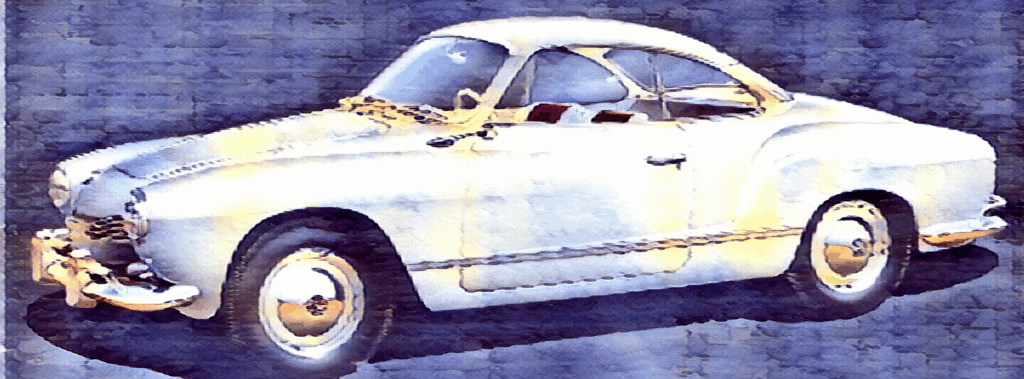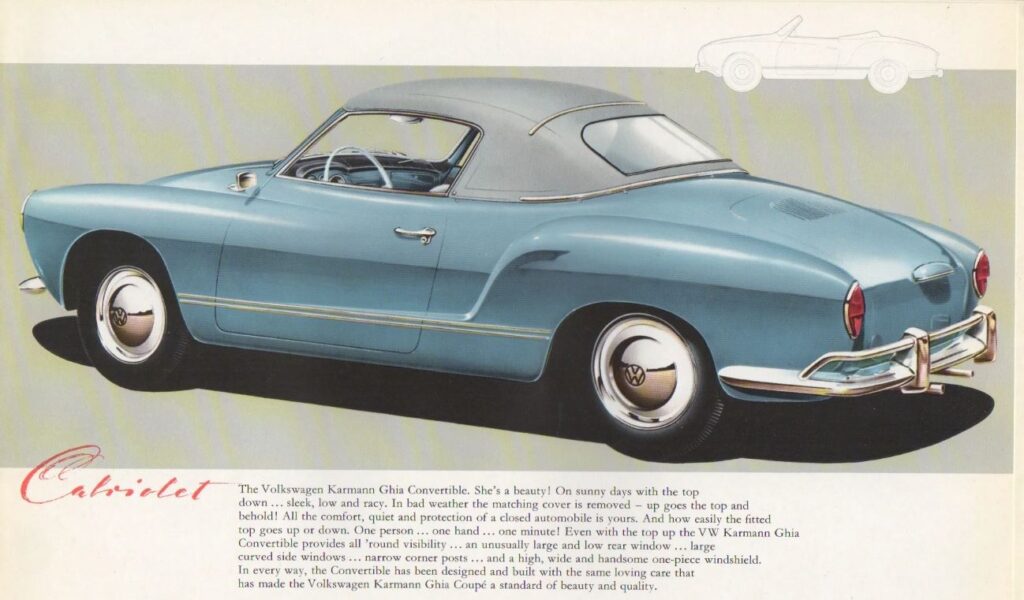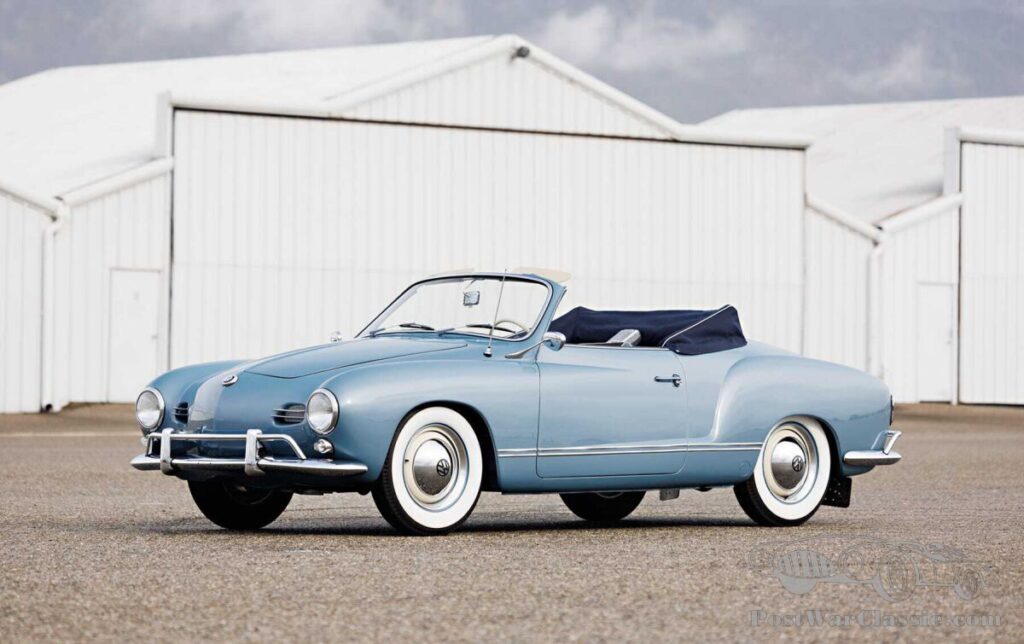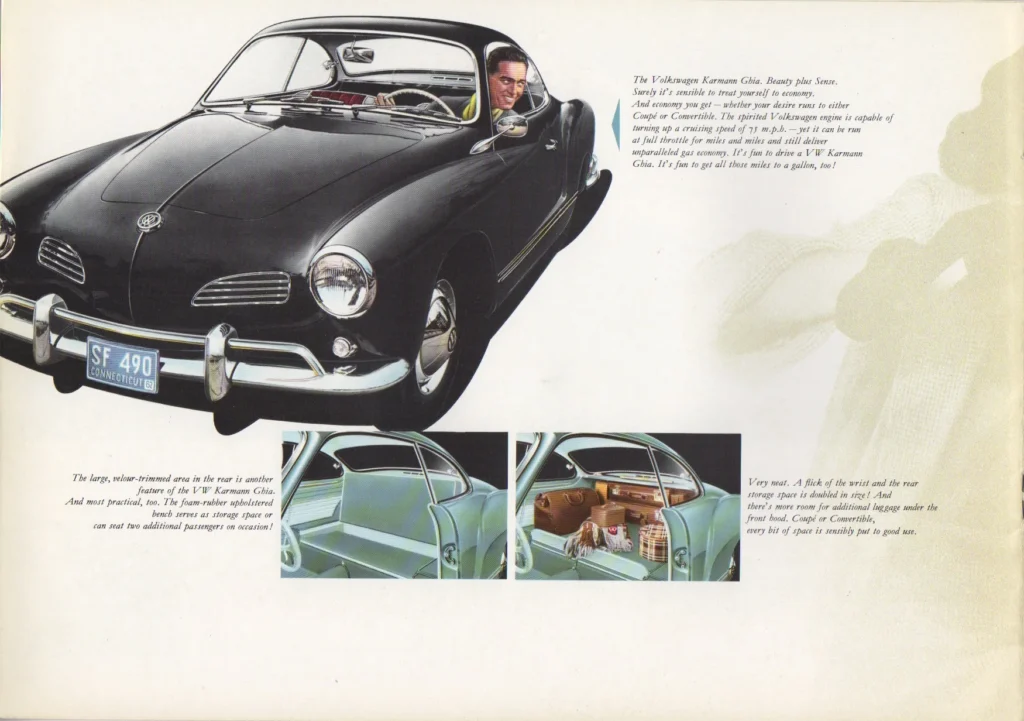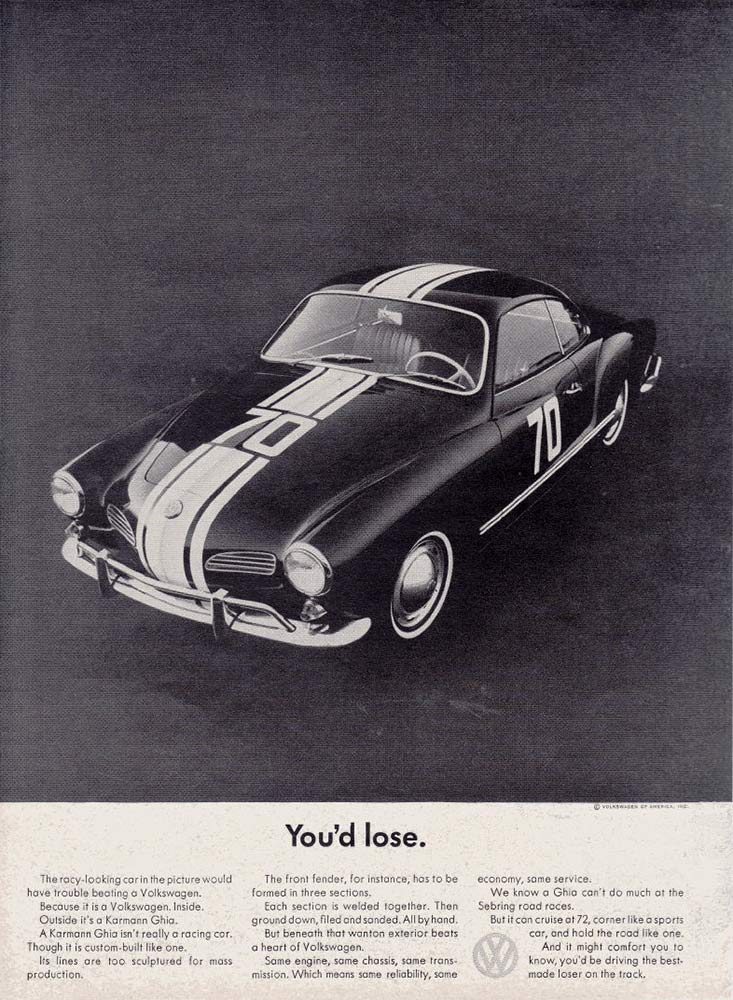Inicio » Our vehicles » VW Karmann Ghia
Share in:
VW Volkswagen Karmann Ghia
Origin: France, 1964
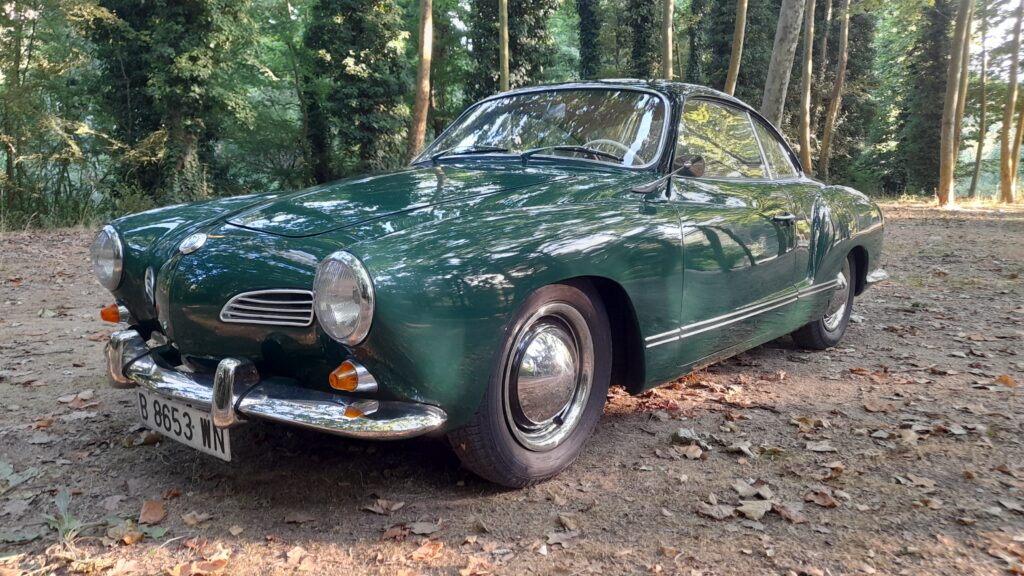
The car you see is our Volkswagen Karmann Ghia, a second series unit , European format, corresponding to the year 1964. This model is distinguished by retaining the original chrome bumpers, with sleeker and more elegant lines than the later American versions.
The Karmann Ghia represents one of the most elegant and refined forms of classic Volkswagen mechanics and in the opinion of many experts, one of the most beautiful designs in automotive history: Aesthetics conceived by the Italian coachbuilder Ghia, assembled by Karmann and animated by the robust Beetle technique, in a unique combination of Italian art and German engineering.
The origin of this unit is French, and it was imported to Spain in the 1990s, probably with a couple of owners since then. More recently, the car was in Mallorca, from where we brought it.
The Karmann has undergone a complete restoration of bodywork, chassis and upholstery, and in a second phase, of the engine. The interior has been redone in camel color, a tone that, although not exactly the original scheme, harmonizes excellently with the dark green of the body and the black of the roof, giving it a warm and elegant air without breaking the aesthetic coherence of the VW aircooled of the sixties.
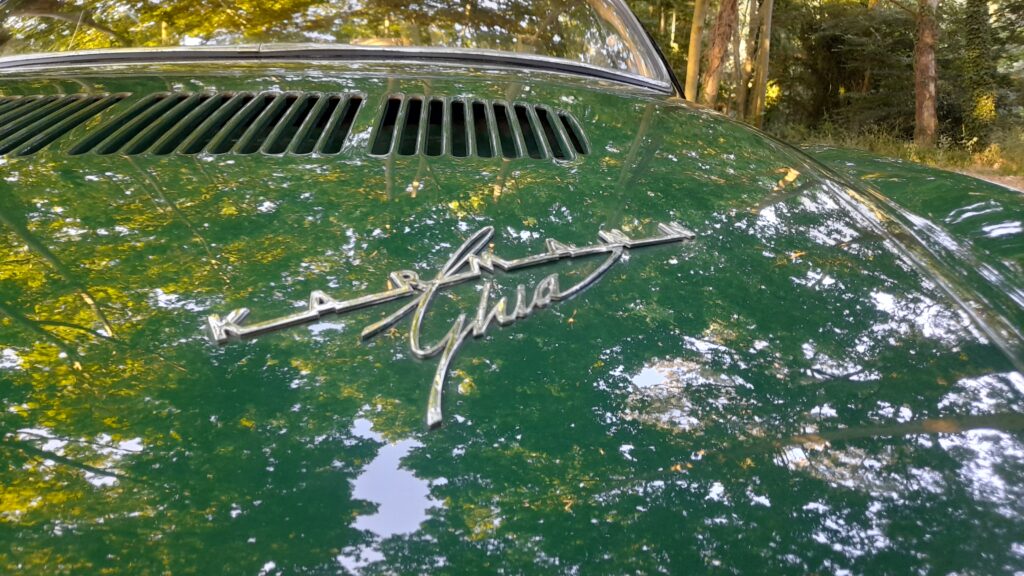
The engine was completely rebuilt less than 400 km ago by a prestigious specialized workshop in Mallorca, focused on air-cooled Volkswagen mechanics. The car is therefore in the break-in phase, with very fine running and an elastic response typical of these well-tuned engines.
As you will see in the gallery, the level of detail and cleanliness of the engine bay is exceptional. The entire intake, ignition and cooling system has been assembled respecting the original layout, with a result that conveys the care taken at each stage of the restoration.
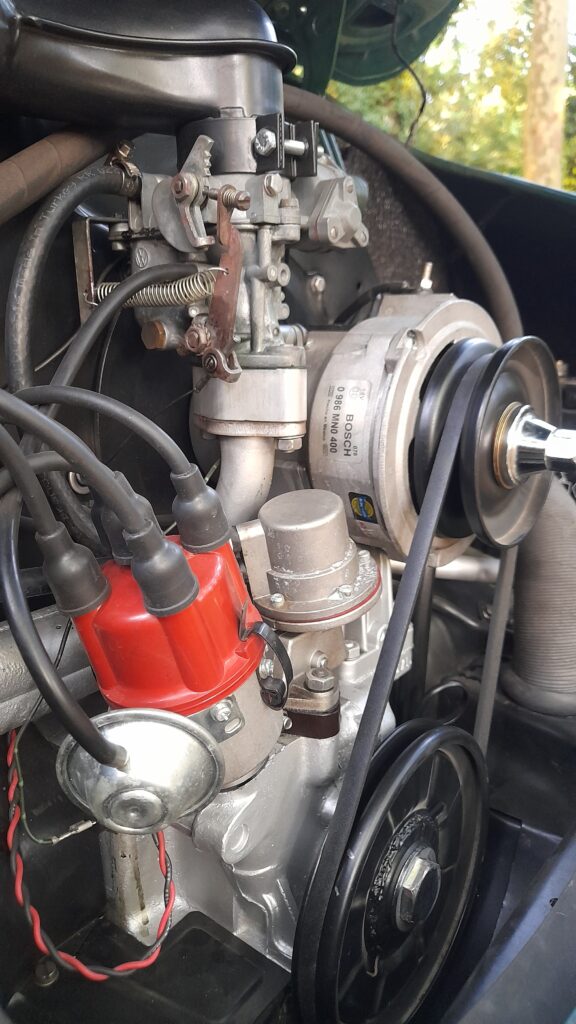
This vehicle is currently in circulation and available for available for rent if you need it for a photo shoot, filming or exhibition; contact us if you have any need related to the vehicle so we can help you.
Also, if you are an owner or future buyer of one of these models and you need any information about parts, spare parts, or technical information you may need, please contact us because we will be happy to share it with you.
VW Karmann Ghia. Photo album. Click on each category:
VW Karmann Ghia - History
After World War II, the European automotive industry focused for years on meeting basic mobility needs. Volkswagen, with the success of its Beetle, had fulfilled precisely that role: to offer a reliable, simple and economical car to rebuild a country. However, as the 1950s progressed, society began to reorient its aspirations. The public began to look for cars with a more emotional and aesthetic component, not just a functional one.
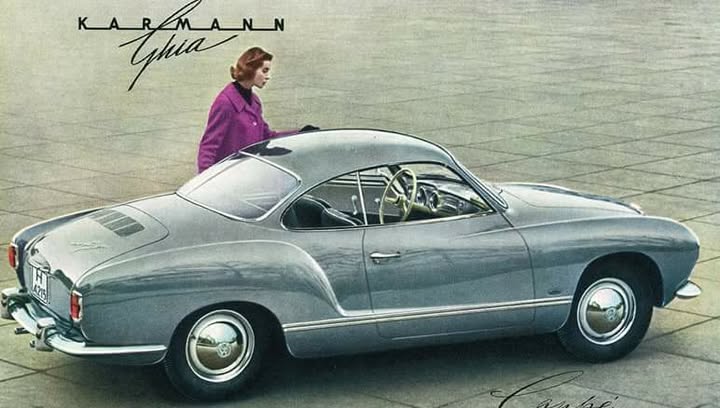
It was then that Wolfsburg came up with the idea of creating a vehicle that, without renouncing the mechanical simplicity and robustness of the brand, would project a more refined and passionate image. Thus was born the Volkswagen Karmann Ghia project, conceived to unite German engineering with the elegance of Italian design.
The Volkswagen Karmann Ghia was the first Volkswagen sports model, produced between 1955 and 1974, initially as a coupe 2 + 2 seats and, from 1957, also in convertible version (convertible). Its name comes from the collaboration between the German coachbuilder Karmann (in charge of manufacturing) and the Italian design house Carrozzeria Ghia (responsible for styling). The result was a car with smooth lines and refined style mounted on the platform of the VW Beetle, from which it inherited its simple rear boxer engine and its renowned reliability. Although its power was modest for a sports car (initially ~30 hp with a 1200 cc engine), its Italian design and German mechanical robustness gave it a unique appeal, accompanied by an affordable price for the time.
The Karmann Ghia was an immediate commercial success. In August 1955, the first production model left the Osnabrück (Germany) plant, and the public’s reception exceeded expectations: more than 10,000 units were sold in the first year. Volkswagen soon had to double daily production to meet demand. During its production period, more than 445,000 Karmann Ghia were assembled in Germany and another 41,000 in Brazil, which was another important market for this model. In fact, the Karmann Ghia became the best-selling imported car in the United States in the late 1950s, thanks to the combination of its exotic appearance with the reliability and low fuel consumption that the public associated with Volkswagen. The prestigious industrial designer Walter Dorwin Teague even included the Karmann Ghia in his list of the best designed products in the world, recognizing the timeless beauty of its forms.
VW Karmann Ghia - Origins and model development
After World War II, the European automotive industry focused on meeting basic needs: affordable mobility and reliability. The Volkswagen Beetle represented just that. But by the early 1950s, the public began to demand cars with greater aesthetic and emotional appeal, not just functional ones. In Wolfsburg understood that the time had come to offer a model that conveyed passion and elegance without sacrificing the simple and robust mechanics that defined the brand.
At the beginning of that decade, Volkswagen basically produced utility cars – such as the “Beetle” sedan – characterized by economy and simplicity. CEO Heinz Nordhoff, initially reluctant to “image cars”, eventually accepted the idea of creating an affordable prestige model that would reinforce Volkswagen’s identity. In 1953, he commissioned the coachbuilder Karmann, which already produced Beetle cabriolets, to develop a sports coupé.
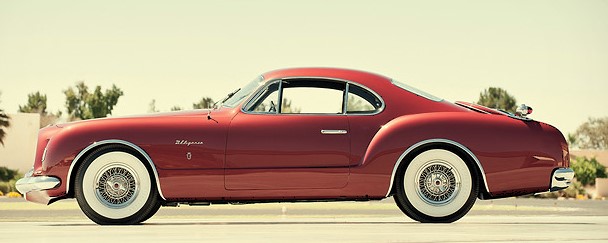
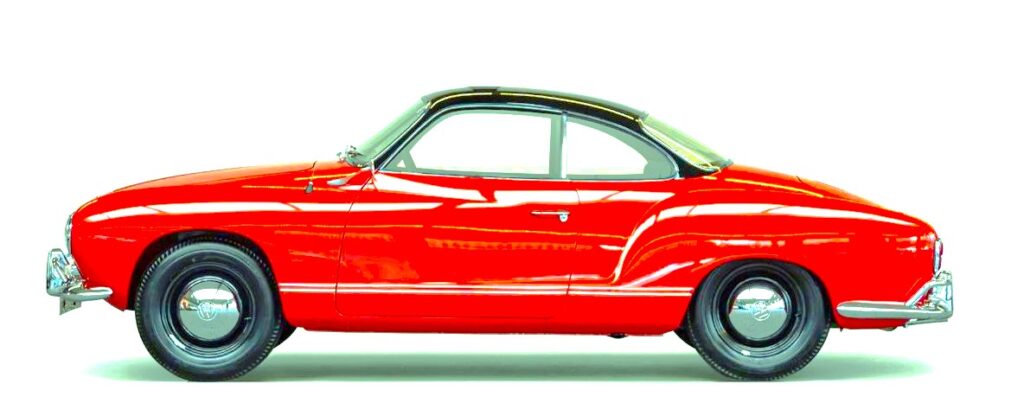
Wilhelm Karmann then turned to Carrozzeria Ghia in Turin, where designer Luigi Segre took a previously unused design (originally conceived for Chrysler or Studebaker) and adapted it on a Beetle chassis widened ~30 cm to give it greater proportions. The prototype, unobtrusively presented in 1953, excited Volkswagen executives, who authorized its series production.
The body of the Karmann Ghia was handcrafted in steel, unlike the more automated processes of the Beetle, which made it more expensive to produce. For example, in 1955 it cost around DM 7,500, almost twice as much as a standard Beetle (DM 3,790). Even so, Volkswagen kept the Karmann Ghia in a reasonable price range for a sports car, well below the Italian exotic cars or the Porsche 356, facilitating access to a wider audience. The final model retained the complete mechanics of the Beetle – air-cooled rear boxer engine, transmission and suspensions.
The first units of the Type 14 coupe were delivered in October 1955. Officially it was a 2+2 seater, although the rear seats were symbolic. Equipped with the 1,192 cc, 30-34 hp engine of the “Beetle Export”, it reached about 120 km/h, aided by a more aerodynamic bodywork. Curiously, the first examples did not include a fuel gauge, using instead a mechanical reserve, just like the Beetle.
In August 1957 Volkswagen launched the long-awaited convertible version (Type 14 cabriolet) of the Karmann Ghia. Building a convertible required additional body reinforcements, but the result was very satisfactory: the Karmann Ghia convertible was considered more elegant than the Beetle Cabrio itself, thanks to its lower and more stylish hood. The popularity of the open-top version grew especially in sunny markets such as California and Florida, where the moderate speed limits of the time made it possible to enjoy the ride without demanding high performance. Between 1957 and 1974, 80,837 units of the Karmann Ghia convertible were produced in Germany (and a few in Brazil, as we will see below). With the coupe and convertible, Volkswagen had managed to introduce a car with an aspirational image, while affordable, consolidating the global reputation of the brand during the 60s.
Karmann Ghia versions and evolution
Throughout its life, the Karmann Ghia gave rise to three main variants: the original Type 14 model (coupe and cabriolet), an extended version called the Type 34 and an exclusive edition for the Brazilian market called the Karmann Ghia TC. Their characteristics are summarized below:
Karmann Ghia Type 14 (1955-1974)
The Type 14 was the original and most iconic model. Its design hardly changed in two decades, except for slight tweaks: in 1960 the headlights were raised (the first “low-lights” of 1955-59 had them lower) and, over the years, taillights and chrome details were enlarged. Mechanically it followed the evolution of the VW Beetle, going from 1200 cc engines (30-34 hp) to 1600 cc (50 hp approx.).
It was never a fast car, but it was reliable, balanced and easy to maintain, sharing almost all its mechanics with the Beetle. It was manufactured in Germany and Brazil. Interestingly, a local convertible version was even launched in Brazil in 1967, of which only 177 units were assembled before it was cancelled, making it one of the rarest and most sought-after variants by collectors. Today type 14 remains the most recognizable and popular of the saga.
Karmann Ghia Type 34 (1961-1969)
Introduced in 1961, the Type 34 was a larger and more exclusive version based on the VW Type 3. It was equipped with a 1500 cc (later 1600 cc) engine and a more angular design, known as “Razor Edge”. It offered better interior space, an enlarged trunk and details uncommon in VW, such as an optional electric sunroof.
It was also the most expensive and fastest of the Karmanns, which limited its sales (42,500 units). It was not officially offered in the U.S., nor was there a convertible version. Today it is one of the rarest and most valued models among collectors.
Karmann Ghia TC (1970-1975, Brazil)
Manufactured by Volkswagen do Brasil, the Karmann Ghia TC (Touring Coupé) was a complete redesign based on the Brazilian VW 1600. Its 1970s-style fastback body was vaguely reminiscent of the Porsche 911.
It was powered by a 65 hp 1.6 L engine with twin carburetors, disc brakes and good dynamic balance. However, its high price and local competition (Puma GT, VW SP2) reduced its sales.
With some 18,000 units produced, it marked the end of the Karmann Ghia era, replaced in 1974-75 by the Volkswagen Scirocco.
Karmann Ghia as a classic today (2025)
More than half a century after its launch, the Karmann Ghia has established itself as a classic car icon. Its timelessly attractive lines and bi-national history (German engineering with Italian design) give it a special aura at vintage car shows and rallies. Enthusiasts appreciate that, unlike many sports cars of its era, the Karmann Ghia is relatively easy to maintain: mechanically it is almost a VW Beetle, with an abundance of spare parts and mechanical simplicity. This, coupled with its bulletproof reliability, allows many owners to still enjoy it regularly on the road, despite its age.
In the classic market, the Karmann Ghia has seen its price rise in recent decades. Especially the convertible versions and the first well restored low-light models reach appreciable prices, although they are still infinitely more affordable than contemporary sports cars such as the Porsche 356 or the Mercedes SL “Pagoda”. This has contributed to its reputation as the “people’s Porsche”, an affectionate nickname that emphasizes that it offers a similar aesthetic experience to a classic Porsche, but at a much lower cost. For example, in Brazil it was nicknamed “O Porsche do Pobre” (the Porsche of the poor) in allusion to this quality.
VW Karman Ghia. Curiosities and anecdotes
- Design inherited from a prototype: The Karmann Ghia’s stylish appearance did not come entirely from scratch. Ghia took advantage of a previous design originally created for a Chrysler show car in the early 1950s (the Chrysler D’Elegance, designed by Virgil Exner), adapting it for Volkswagen after it had not been used by the American brand. This “creative reuse” explains the unusual sophistication of its lines for a car of its segment.
- Craftsmanship: Unlike the Beetle, whose production was highly mechanized, each Karmann Ghia was built with steel panels welded and molded largely by hand. This handcrafted process ensured excellent finishes and fit, but made the car more expensive. As a result, a Karmann Ghia cost significantly more than a Beetle – something the customer noticed when looking at details such as the more refined interior and sculpted body shapes.
- The slowest “sports car”: With 34 hp from the factory, the Karmann Ghia of the mid-50s accelerated from 0 to 100 km / h in about 36 seconds, a time even slower than some contemporary utilities. However, few buyers blamed it for the lack of power, as it was not bought for racing, but for cruising in style. An Autoweek columnist summed it up thus: “slower, but nicer than any Porsche”.
- Export to the USA: More than 50% of Karmann Ghia production was destined for export, with the United States being the largest international buyer. In the 1960s it topped the American sports car import charts, surpassing European models such as the Triumph Spitfire or MG Midget in popularity. This is attributed to the fact that American soldiers stationed in Germany got to know the model there and contributed to its diffusion by bringing it back home.
- Production rarities: In addition to the aforementioned very low production of the Brazilian cabriolet (177 units), there are other curious details. All Karmann Ghia were officially manufactured in two factories: Karmann in Osnabrück (Germany) and Volkswagen do Brasil in São Bernardo do Campo. It was never produced in Mexico, although in this country the model enjoyed popularity among private importers.
Conclusion
The Volkswagen Karmann Ghia remains a beloved classic. It combines the elegant aesthetics of an Italian sports car with the rugged simplicity of a Volkswagen, a formula that has secured it a special place in automotive history. Its legacy lives on not only in classic clubs and vintage events, but also in the inspiration it provided to later models. Volkswagen has never reissued a “new” Karmann Ghia, but it did explore the concept of accessible coupes with models such as the Scirocco or the Corrado in later decades – all of them indebted, in spirit, to that first successful Wolfsburg experiment in creating a sports car for the masses. The Karmann Ghia, with its retro charm and interesting history, remains synonymous with timeless design and classic driving pleasure, a true “Beetle in an Italian suit” that today arouses smiles and nostalgia in equal measure.
As production ceased in 1974-75, Volkswagen did not have a direct global successor until decades later; models such as the New Beetle (1998) or the Volkswagen Karmann Ghia Coupe concept (introduced in 1990) have sporadically paid tribute to this classic, but the original remains irreplaceable.
